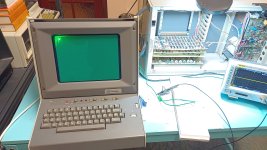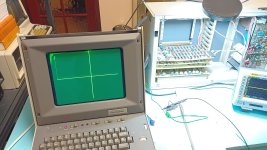thunter0512
Veteran Member
Edit: the above is incorrect. Signal MAKE_COPY nicely follows the momentary "Make Copy" switch. Earlier I counted from the wrong side of the minibus.
Last edited:
Thanks for the offer.If you need any signals checked I have a functional 4010-1.


I checked the oldest Tek Semiconductor Cross Ref manual - 1982 and it lists the Tek part number cross-reference as SE7056 from Fairchild Semiconductor.I have been struggling today with the intensity circuit on the HV & Z-Axis board.
Yesterdays suspect resistors turned out to be fine once I lifted a leg and measured then.
Sometimes there are non-obvious bits which affect your measurement while in-circuit.
Q115 is Silicon NPN transistor in TO-39 package and according to the parts list is a Texas Instruments SGC2622.
It is the power transistor used to regulate & switch between 173 V or 213 V on the HV & Z-Axis board. Unfortunately I cannot find this transistor via Google or by going directly to Bitsavers.
Any ideas where to find a datasheet for a SGC2622.
I wish Tektronix wouldn't bend the ends of pins before soldering them in.
If I don't care for the components I just cut them out with side cutters and unsolder each pin individually to preserve the PCB - this is my preferred way of removing components.
On the other hand if I am dealing with an obscure part I want to preserve or test but where I need to lift a pin or remove the component altogether for testing, then the bent pins are a major obstacle.
Trying to unbend the pin with the tip of the soldering iron in most cases means that you slip off and possibly damage tracks.
Even resistors are painful. Often component leads are remarkably stiff and resist unbending. IC pins are the most cooperative and generally can be unbent with the desoldering iron.
Is there a better/good way of dealing with these damn bent pins?

Thanks David. Probably I am blind as usual but I can't see any reference to part number 152-0061-00 in your Tek D40 Oscilloscope manual.This lists it as CD8393 or FDH2161. Not that I could find any information on those parts.
http://static6.arrow.com/aropdfconversion/b9053a63c53a23d77249b57fc76523f75f71d53a/159-0041-00.pdf
Thank you. Sorry for not spotting the diodes. There are 6 instances of it in your parts list. It is getting late over here again.
